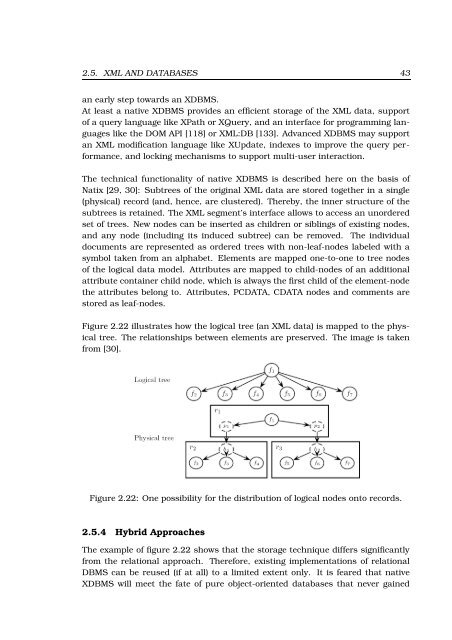url - Universität zu Lübeck
url - Universität zu Lübeck
url - Universität zu Lübeck
You also want an ePaper? Increase the reach of your titles
YUMPU automatically turns print PDFs into web optimized ePapers that Google loves.
2.5. XML AND DATABASES 43<br />
an early step towards an XDBMS.<br />
At least a native XDBMS provides an efficient storage of the XML data, support<br />
of a query language like XPath or XQuery, and an interface for programming languages<br />
like the DOM API [118] or XML:DB [133]. Advanced XDBMS may support<br />
an XML modification language like XUpdate, indexes to improve the query performance,<br />
and locking mechanisms to support multi-user interaction.<br />
The technical functionality of native XDBMS is described here on the basis of<br />
Natix [29, 30]: Subtrees of the original XML data are stored together in a single<br />
(physical) record (and, hence, are clustered). Thereby, the inner structure of the<br />
subtrees is retained. The XML segment’s interface allows to access an unordered<br />
set of trees. New nodes can be inserted as children or siblings of existing nodes,<br />
and any node (including its induced subtree) can be removed. The individual<br />
documents are represented as ordered trees with non-leaf-nodes labeled with a<br />
symbol taken from an alphabet. Elements are mapped one-to-one to tree nodes<br />
of the logical data model. Attributes are mapped to child-nodes of an additional<br />
attribute container child node, which is always the first child of the element-node<br />
the attributes belong to. Attributes, PCDATA, CDATA nodes and comments are<br />
stored as leaf-nodes.<br />
Figure 2.22 illustrates how the logical tree (an XML data) is mapped to the physical<br />
tree. The relationships between elements are preserved. The image is taken<br />
from [30].<br />
Figure 2.22: One possibility for the distribution of logical nodes onto records.<br />
2.5.4 Hybrid Approaches<br />
The example of figure 2.22 shows that the storage technique differs significantly<br />
from the relational approach. Therefore, existing implementations of relational<br />
DBMS can be reused (if at all) to a limited extent only. It is feared that native<br />
XDBMS will meet the fate of pure object-oriented databases that never gained
















